Overview
This article addresses a crucial challenge faced by many startup founders: the need to validate their product concepts effectively. It can be overwhelming to navigate the uncertainties of launching a new idea, especially when resources are limited. The fear of investing time and money into a product that may not resonate with users is a common pain point that many entrepreneurs experience.
However, there is hope. By focusing on creating a Minimum Viable Product (MVP), startups can efficiently test their concepts while minimizing both costs and risks. This approach not only allows for early user feedback but also fosters an environment of iterative development, which is vital for growth. Statistics reveal that approximately 72% of startups utilizing this strategy enhance their chances of success, underscoring the importance of connecting with users early in the process.
As you embark on this journey, remember that you are not alone. Embracing the MVP approach can be a nurturing solution that supports your vision while allowing you to learn and adapt. By prioritizing user feedback and being open to change, you can transform your ideas into successful products that truly meet the needs of your audience. Let this be a step towards building something meaningful together.
Introduction
Defining a Minimum Viable Product (MVP) is a crucial step for startups as they navigate the often overwhelming complexities of product development. Many founders feel the pressure to get it right, grappling with the challenge of identifying which features are truly essential to meet customer needs. This struggle can lead to feelings of uncertainty and anxiety, as entrepreneurs seek to validate their ideas while minimizing costs and risks.
So, how can you ensure that your MVP not only captures interest but also delivers real value to users? This article explores the strategic steps that can help you build a successful MVP, offering insights designed to transform your initial concepts into thriving products. Together, let’s embark on this journey to create something meaningful.
Define the Minimum Viable Product (MVP)
A Minimum Viable Offering (MVO) represents the most basic version of an item that can be launched to the market, incorporating only the essential features needed to satisfy early adopters and facilitate feedback for future enhancements. For many startup founders, the journey of bringing a new offering to life can feel daunting. Defining an MVP is crucial in creating new offerings, as it allows startups to validate their concepts swiftly and effectively, lowering development expenses by as much as 60% compared to conventional approaches. This is a significant relief, especially for those who are navigating the uncertain waters of entrepreneurship. MVPs also allow for quick validation of the riskiest assumptions at lower costs, providing a strategic advantage that can make all the difference. Research indicates that approximately 72% of startups utilize an MVP approach, enhancing their chances of success. Furthermore, startups using a Minimum Viable Product (MVP) methodology are 0% more likely to succeed, underscoring the effectiveness of this approach in achieving sustainable growth.
To effectively define your MVP, consider these supportive steps:
- Identify Core Functionality: Pinpoint the primary function your product must fulfill to address a specific problem for your target audience. This focus ensures that the MVP delivers real value from the outset, easing the burden of uncertainty.
- Concentrate on Customer Experience: Even in its most basic form, the MVP should deliver a satisfactory experience for clients. Prioritize usability to engage initial participants and encourage their feedback, fostering a sense of connection.
- Set Clear Objectives: Focus on defining an MVP and clearly outline what you aim to learn from it, such as engagement levels, functionality validation, or overall market interest. This clarity will guide your development process and help you feel more in control.
- Document Your Definition: Create a concise description that outlines the essential attributes and objectives of your MVP. This documentation will help keep your team aligned and focused throughout the development cycle, ensuring everyone is on the same page.
Successful examples of MVPs in tech startups illustrate the effectiveness of this approach. For instance, companies that test pricing and value propositions with an MVP are about 50% more likely to achieve sustainable revenue models. Moreover, the MVP model encourages a feedback loop between participants and developers, with approximately 70% of companies utilizing MVPs indicating enhanced insights from consumers. By focusing on key elements and collecting user input early, startups can adjust their strategies according to genuine market demands, ultimately resulting in a stronger development process. As Vasyl Kuchma, CEO & Co-Founder, states, "The MVP approach lets startups test their ideas and demand," highlighting the critical role of MVPs in the startup ecosystem. Remember, you are not alone in this journey; embracing the MVP approach can guide you toward success.
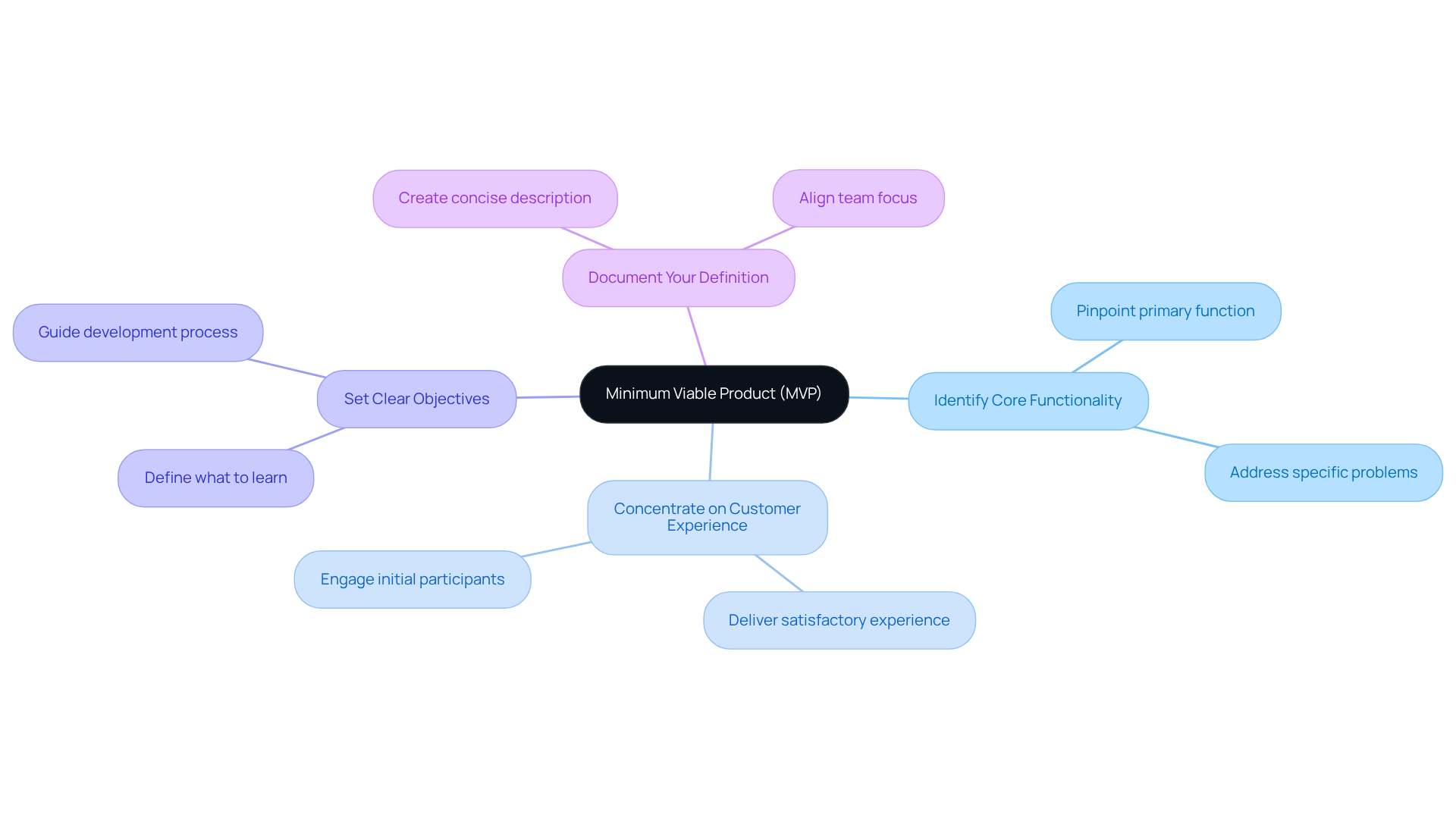
Understand the Importance of an MVP
The journey of developing a product can be daunting, especially when considering the myriad of challenges that tech startup founders face. One of the most pressing issues is the risk of investing time and resources into a solution that may not meet market needs. This is where defining an MVP becomes crucial. By focusing on the core features necessary to test your idea, you significantly reduce the risk of costly missteps. In fact, about 42% of startups fail due to a lack of market demand, underscoring the importance of validating your ideas early on.
Gathering user feedback is another critical aspect of the MVP approach. It allows you to connect with real users and gain invaluable insights that can refine and elevate your offering. Statistics reveal that 65% of businesses utilize feedback from their MVPs to prioritize feature development, which in turn enhances user retention. This process not only nurtures your product but also builds a community around it, inviting your users to share their experiences and needs.
Moreover, defining an MVP is essential as it provides vital market validation by testing the waters. It confirms whether there is sufficient demand for your idea before you dive into full-scale development. Startups that are successful in defining an MVP strategy are 20% more likely to thrive during their first five years, highlighting its effectiveness in validating business assumptions. Remarkably, 72% of startups adopt this approach, reflecting its widespread acceptance in the entrepreneurial landscape.
Cost efficiency is yet another compelling reason to consider an MVP. Developing one can be 50% to 70% more affordable than creating a fully-featured product from the start. This financial flexibility allows you to allocate your resources wisely, making it easier to pivot based on user insights and market feedback. Take Dropbox, for instance; their initial MVP, an explainer video, attracted over 75,000 sign-ups overnight, showcasing how a simple, thoughtful approach can generate significant interest without requiring extensive upfront costs. Similarly, Etsy managed to develop its MVP in just two and a half months, leading to remarkable growth in a competitive market.
The MVP concept gained official recognition through Eric Ries’s Lean Startup methodology, which emphasizes defining an MVP as significant in today’s development landscape. By embracing the MVP approach, you not only mitigate risks but also foster a deeper connection with your users, paving the way for sustainable growth and success.
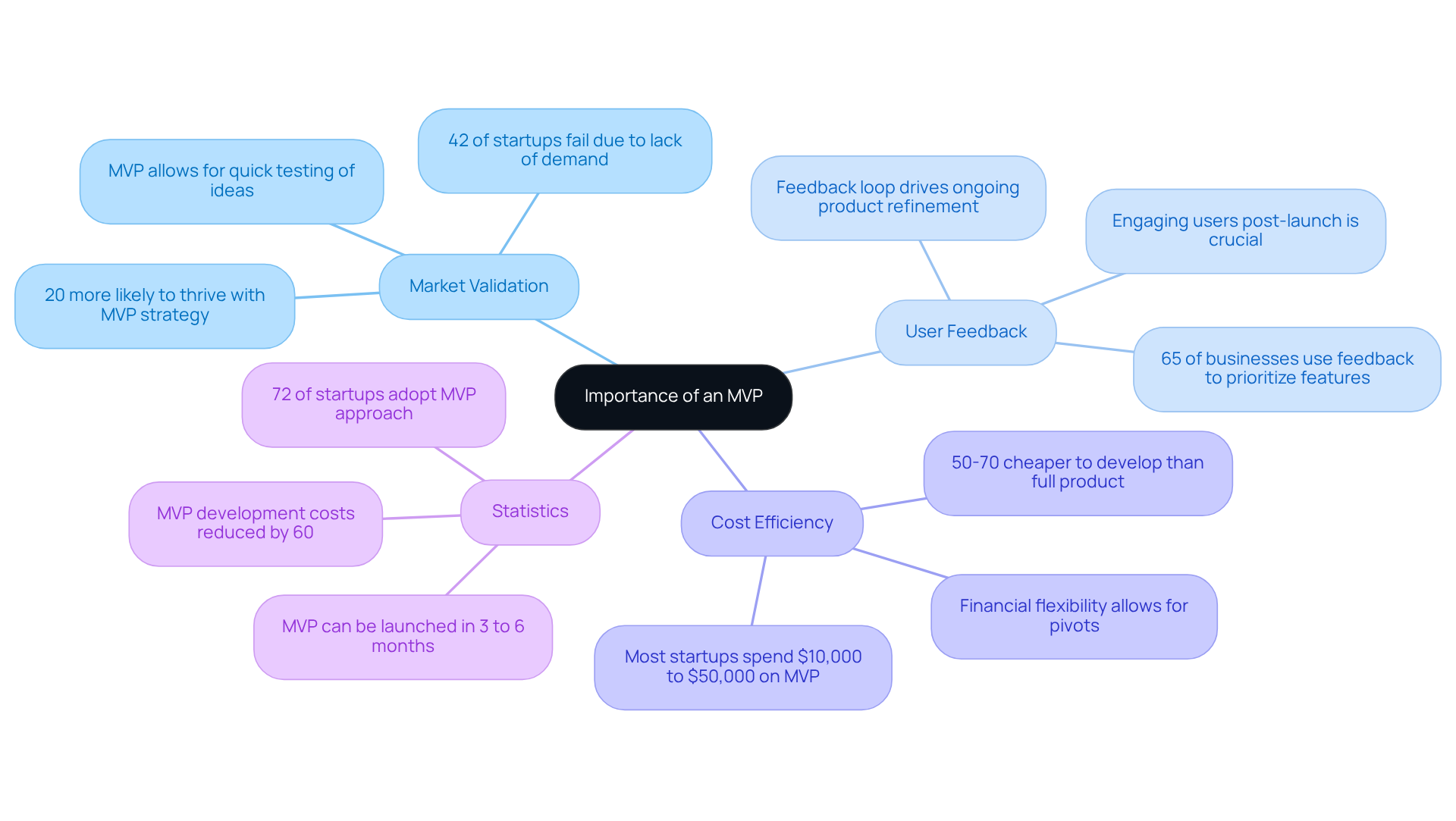
Identify Customer Needs and Market Gaps
To effectively identify customer needs and market gaps, it's essential to approach the task with empathy and understanding. Many startup founders struggle with truly grasping what their customers want, which can lead to frustration and missed opportunities. By addressing this challenge, you can create a product that resonates deeply with your audience. Here are some nurturing steps to guide you:
-
Conduct Market Research. Engage with your target audience through surveys, interviews, and focus groups. This will help you uncover their pain points and preferences, allowing you to connect with them on a personal level.
-
Analyze Competitors. Take the time to study existing products in the market. Identify what they excel at and where they may be lacking. This analysis will reveal gaps that can be addressed by defining an MVP, offering a unique solution that meets customer needs.
-
Create User Personas. Develop detailed profiles of your ideal customers, including their demographics, behaviors, and needs. This practice not only fosters a deeper understanding of your audience but also helps you empathize with their experiences.
-
Utilize Online Tools. Leverage platforms like Google Trends, social media, and forums to gather additional insights into customer interests and market trends. These resources can provide valuable information that enhances your understanding and connection with your audience.
By following these steps, you can foster a nurturing environment for your startup, ensuring that you are attuned to the needs of your customers and ready to meet them with compassion and expertise.
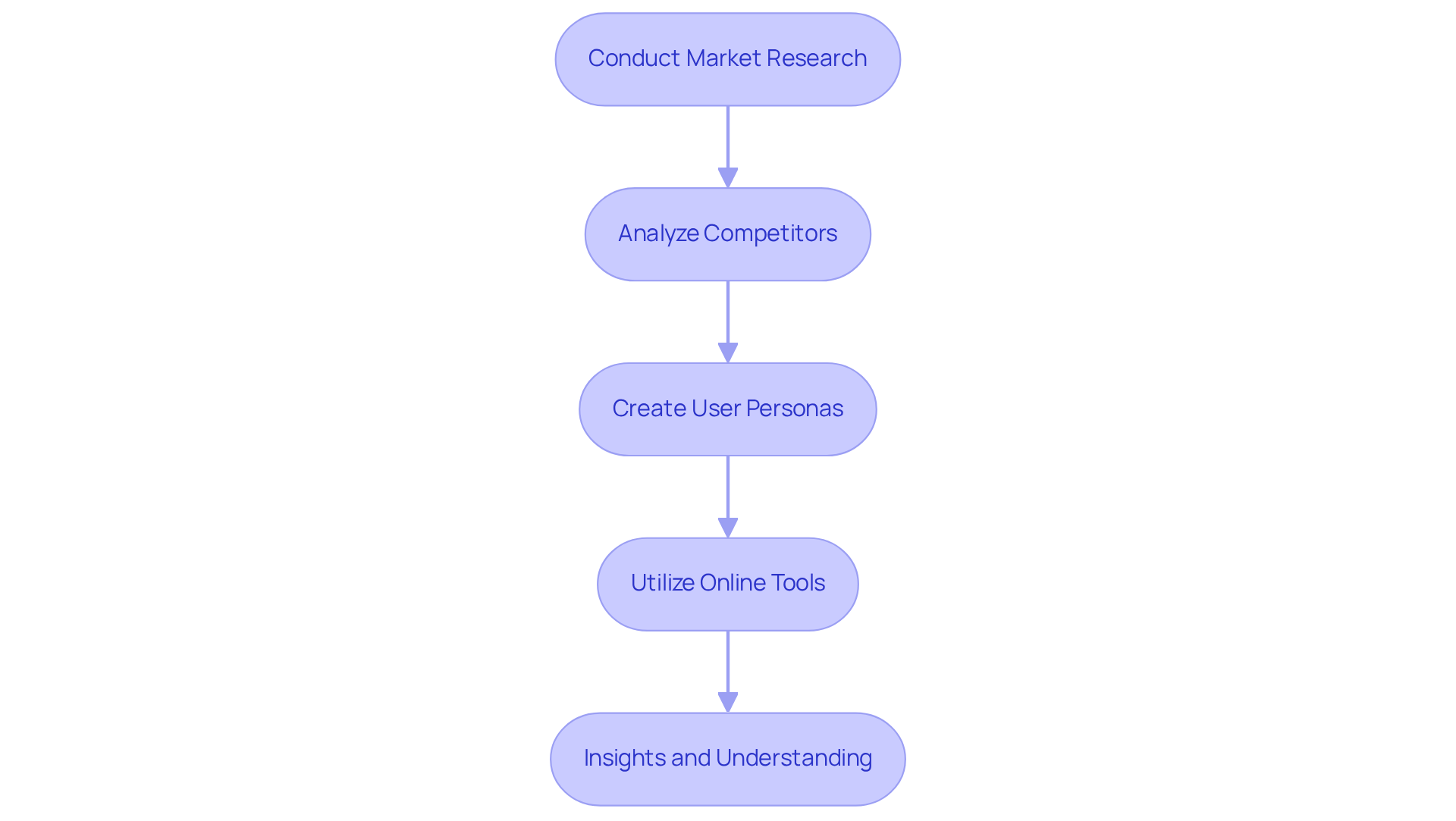
Prioritize Features for Your MVP
Defining an MVP can feel overwhelming when prioritizing features, especially when you’re passionate about your vision. Many startup founders struggle to determine which features truly matter, leading to frustration and delays in development. It’s essential to navigate this challenge thoughtfully to ensure your product resonates with your audience.
One effective approach is the MoSCoW Method. This framework categorizes features into four groups:
- Must-haves
- Should-haves
- Could-haves
- Won't-haves
By honing in on the essentials, you can prioritize critical functionalities for immediate implementation, streamlining your development process. Many teams have found success with this method, as it not only enhances prioritization but also fosters collaboration among team members.
Another valuable strategy is to gather User Feedback. Engaging with your target audience through surveys or interviews helps you understand what they truly value. This step is vital; statistics reveal that nearly 90% of startups fail, often due to a disconnect with market needs. By truly listening to your customers, you can ensure that defining an MVP aligns with their genuine expectations and desires.
Consider employing the Impact vs. Effort Matrix as well. This method assesses features based on their potential impact on user satisfaction versus the effort required for implementation. Visualizing this relationship allows you to prioritize high-impact features that are feasible to develop, optimizing your resources effectively.
Additionally, an Iterative Approach can be beneficial. Start with a basic set of features and plan for gradual enhancements based on feedback after launch. This method allows for flexibility and responsiveness to client needs, ultimately improving your product’s relevance and effectiveness over time.
You might also explore the Weighted Shortest Job First (WSJF) framework, which prioritizes features by calculating the Cost of Delay divided by job size. This approach maximizes the value you deliver to your clients. By focusing on customer feedback and employing structured frameworks, you can significantly boost your chances of defining an MVP that is successful.
Remember, you’re not alone in this journey. Many founders have faced similar challenges, and by implementing these strategies, you can navigate the path to success with greater confidence and clarity.
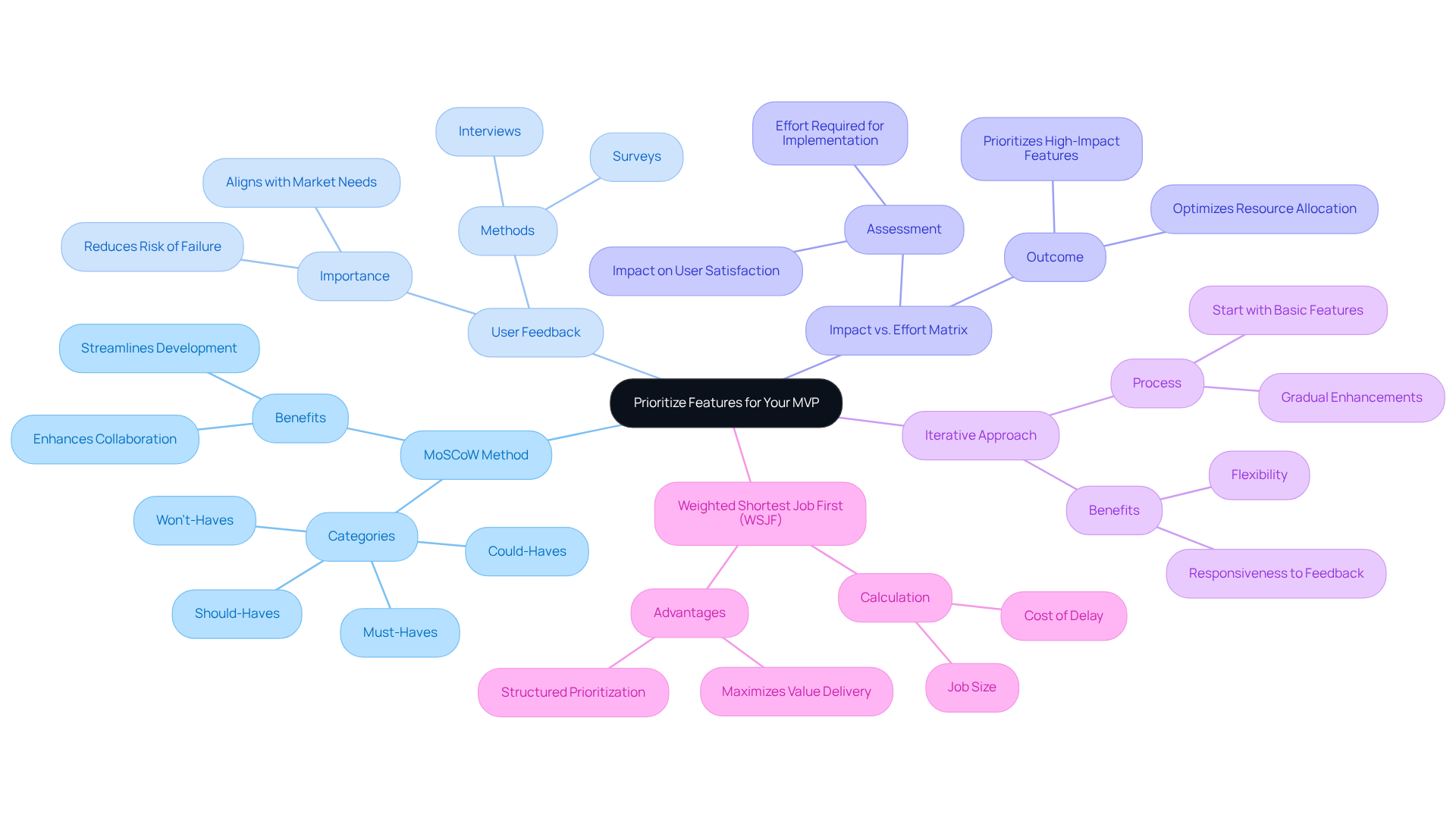
Build, Test, and Iterate on Your MVP
Building, testing, and iterating on your product is a crucial part of defining an MVP, which can feel like a daunting journey that significantly influences your startup's success. Many founders grapple with the pressure of getting it right, often questioning whether their initial efforts will resonate with potential users. This anxiety is common, but there is a path forward that can ease these concerns.
-
Create the MVP: Collaborate closely with your development team to build the MVP, focusing on the features that will deliver the greatest benefit to your clients. This initial version should be functional enough to attract early adopters and provide valuable insights into user behavior. Remember, companies that focus on defining an MVP approach often experience a 35% reduction in development time, thanks to innovations in web and mobile technologies.
-
Conduct Participant Testing: Once your MVP is ready, launch it to a select group of individuals. This step allows you to observe how they interact with your product and gather both qualitative and quantitative feedback. It’s essential to understand that approximately 70% of companies defining an MVP report gaining improved insights from their clients, which can guide future enhancements. Moreover, startups that are successful in defining an MVP are about 50% more likely to establish sustainable revenue models, highlighting the importance of this phase.
-
Analyze Feedback: Take the time to carefully review the feedback collected during user testing. Identify areas for improvement and features that may need adjustment. Startups that are defining an MVP for evaluation are about 50% more likely to achieve sustainable revenue models, underscoring the value of this analysis. Additionally, companies that excel in defining an MVP often secure seven times more funding than those that don’t, showcasing the financial advantages of this approach.
-
Iterate: Based on the insights gathered, make necessary changes to the MVP and prepare for a broader launch. This iterative process is vital; startups that are defining an MVP frequently experience 30% more modifications than those following traditional methods. Continuous improvement ensures your product aligns with market demands and consumer expectations. The anticipated 50% reduction in development timelines for defining an MVP by 2024, driven by advanced technologies, further emphasizes the significance of this iterative approach.
By following these steps, you can navigate the process of defining an MVP with confidence, using user feedback to create a product that truly resonates with your target audience. This not only enhances your chances of long-term success but also fosters a sense of community among fellow founders. Successful case studies, such as the e-learning platform and financial wellness app developed by Artkai, illustrate how effective MVP strategies can lead to remarkable market success. Embrace this journey with an open heart, knowing that each step you take brings you closer to your vision.
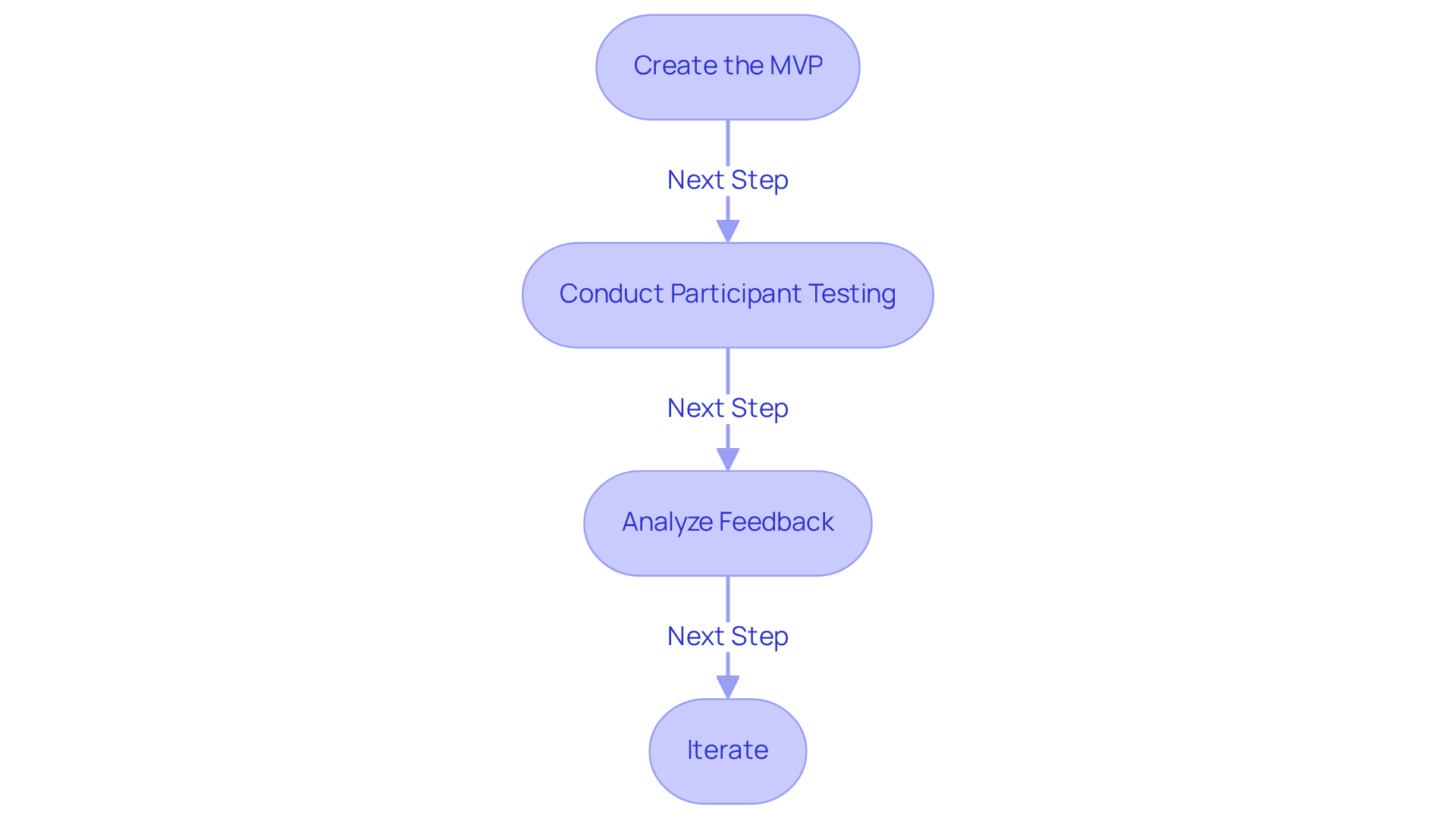
Conclusion
Defining a Minimum Viable Product (MVP) can feel daunting for many startups. The complexities of product development often leave founders feeling overwhelmed and uncertain. Yet, by focusing on the essential features that truly meet customer needs, entrepreneurs can alleviate some of these pressures. This approach not only minimizes risks and costs but also enhances the likelihood of success. It’s a way to validate ideas swiftly, fostering a genuine connection with users that can lead to sustainable growth.
Throughout this article, we've explored key strategies for defining an MVP. We’ve discussed the importance of:
- Identifying core functionalities
- Prioritizing user experience
- Embracing customer feedback for ongoing improvement
Setting clear objectives and documenting the MVP definition is crucial; these elements keep teams aligned and focused on their shared goals. The success stories of companies like Dropbox and Etsy serve as powerful reminders of the tangible benefits of adopting an MVP strategy, demonstrating how thoughtful execution can lead to remarkable market success.
In a landscape filled with uncertainty, embracing the MVP approach is not just a tactical choice; it’s a strategic necessity. By prioritizing user needs and iterating based on real feedback, startups can create products that resonate deeply with their audience. This journey transcends merely launching a product; it’s about building a community and nurturing innovation. We encourage you to take action now, leveraging the insights shared to define your MVP and embark on a path toward lasting impact and success. Remember, you are not alone in this journey; every step you take is a step toward creating something meaningful.
Frequently Asked Questions
What is a Minimum Viable Product (MVP)?
A Minimum Viable Product (MVP) is the most basic version of a product that can be launched to the market, containing only the essential features needed to satisfy early adopters and gather feedback for future improvements.
Why is defining an MVP important for startups?
Defining an MVP is crucial as it allows startups to validate their concepts quickly and effectively, reducing development costs by up to 60% and helping to identify the riskiest assumptions at lower costs.
How does the MVP approach benefit startups?
The MVP approach benefits startups by enhancing their chances of success; approximately 72% of startups utilize this method, which increases their likelihood of thriving in the market.
What are the key steps to effectively define an MVP?
Key steps include identifying core functionality, concentrating on customer experience, setting clear objectives, and documenting your definition to keep the team aligned throughout development.
How does user feedback play a role in the MVP process?
User feedback is essential as it provides insights that refine and improve the product. About 65% of businesses use feedback from their MVPs to prioritize feature development, which enhances user retention.
What is the impact of an MVP on market validation?
An MVP helps confirm whether there is sufficient market demand for an idea before committing to full-scale development, increasing the likelihood of success by 20% during the first five years for startups that implement an MVP strategy.
How cost-effective is developing an MVP compared to a fully-featured product?
Developing an MVP can be 50% to 70% more affordable than creating a fully-featured product from the start, allowing startups to allocate resources more wisely and pivot based on user insights.
Can you provide examples of successful MVPs?
Successful MVP examples include Dropbox, which used an explainer video to attract over 75,000 sign-ups overnight, and Etsy, which developed its MVP in just two and a half months, leading to significant growth.
What methodology recognizes the importance of the MVP concept?
The MVP concept gained official recognition through Eric Ries’s Lean Startup methodology, which emphasizes its significance in the current development landscape.




